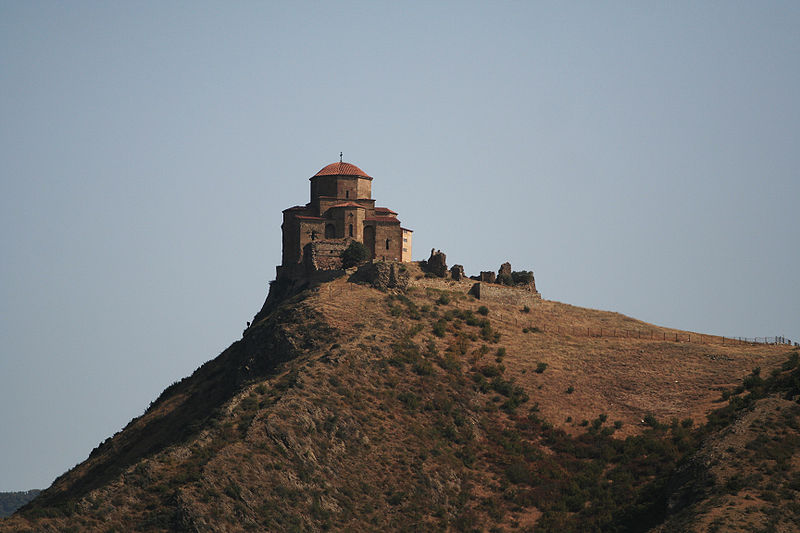
Mtskheta is a UNESCO World Heritage Site. It has been inhabited since before 1.000 BC and was once the capital of the early Kingdom of Iberia, (today’s Eastern Georgia).
Just 20 km from today’s capital Tbilisi, situated at the confluence of the Mtkvari and Aragvi rivers, the city is located on an ancient trade route. Archaeologists have unearthed evidence of Mtskheta’s status as a major trading post. Glass perfume bottles, Greek and Aramaic writings, pottery, metalwork and jewellery are all found in abundance beneath the ground here, and many examples are on show in the town’s fine Museum.
The ancient geographer Strabo described Mtskheta as a highly developed city with a water supply system, markets and stone houses. Mtskheta was also the religious centre of the country, with a number of major shrines to Georgia’s pagan pantheon; these would later be replaced by churches when St. Nino converted the country to Christianity in around 337 AD.
Although the capital was moved to the more easily defended Tbilisi at the beginning of the VI century, Mtskheta continued to be the coronation and burial place of Georgian kings, and the seat of the Patriarch, who is also known as the Bishop of Mtskheta. Today, the lovely old town has a laid back, village feel, especially after the more hectic pace of Tbilisi.
1. Svetitskhoveli Cathedral
Georgian architectural monument dating back to the XI century had been the religious center of the country for hundreds of years. The complex includes the church, a gate, a bell tower, castles and clerical residences. The mantles of Christ and of the Prophet Elijah are both preserved in the Svetitskhoveli Cathedral. The cathedral is included on the UNESCO World Heritage Site List.
2. St. Nino Monastery
The complex is located in the city center of Mtskheta, and dates back to the XI century. From this holy place, St. Nino of Cappadocia preached Christianity to the Georgian people. The first Christian King Mirian, Queen Nana and Assyrian father Abibos Nekreseli are all buried here. The complex includes: the main cathedral, St. Nino Church, a bell tower and a citadel wall.
3. Mtskheta State Archaeological Museum-Reserve
The Museum-Reserve contains archeological monuments of national and world importance. Wide variety of exhibits of the Bronze, late Middle Ages, and ethnographic artifacts are also preserved in the Museum-Reserve.
4. Bebristsikhe
Bebristsikhe castle is located north of Mtskheta, on the right bank of the river Aragvi. It was called Belta in ancient times. The castle was built in the antique period; its total area equates to approximately 1500 m2 and the inner courtyard is about 600 m2.
5. Jvari Monastery
The VI century Georgian Orthodox monastery is built on a hill, opposite of Mtskheta, at the confluence of Aragvi and Mtkvari rivers. Shortly after the adoption of Christianity, King Mirian III erected a wooden cross in this place. In the 2nd half of the VI century Guaram, the ruler of Kartli, built a little church beside the Holy Cross. The church is included on the UNESCO World Heritage Site List.
6. Armaztsikhe (Bagineti)
Archaeological and historic Monument (IV BC – VIII AD) is located along Mtskheta-Tbilisi highway. Its name is linked to the idol Armazi which was proclaimed the supreme deity by King Parnavaz. Archeological findings on the territory of Armaztsikhe include: ruins of the wall, towers, structures of the royal residence and the ruins of the burial vault. The locals refer to Armaztsikhe as Bagineti.
7. Armazi Fortress
Considering its scale and antiquity – Armazi is one of the most important fortresses in the country. Currently, remains of the fortress occupy 30 hectares. The fortress used to block the road to the bordering countries beyond the Caucasus.
8. Monastery of Shio-Mgvime
The monastery is located 8 km from Mtskheta, on the left bank of the river Mtkvari. It was constructed in the beginning of the 2nd half of the VI century by one of the Assyrian fathers named Shio. The complex includes facilities of different time periods: a cave church, St. John Baptist Church, a bell tower, church of Shio, St. Mary’s Assumption Cathedral with a tower, refectory, rock-cut caves – reservoirs, clergy houses, a spring, water supply system and the Ascension Church.
9. Zedazeni
The Zedazeni complex is located 6 km south of Saguramo, on the top of a mountain covered in deep forests. The complex includes: St. John Baptist Church, the fortress and cave cells.
10. Ilia Chavchavadze Saguramo State Museum
The museum complex includes a residential house, auxiliary buildings and the family vineyards of the famous Georgian writer and public figure Ilia Chavchavadze (1837-1907). The museum preserves memorial items and manuscripts of the writer; photo portraits of the famous XIX century Georgian public figures and photographs reflecting the time period. Location: village Saguramo
COPYRIGHT © "TR TRAVEL" LTD 2014 - 2025. ALL RIGHTS RESERVED.






